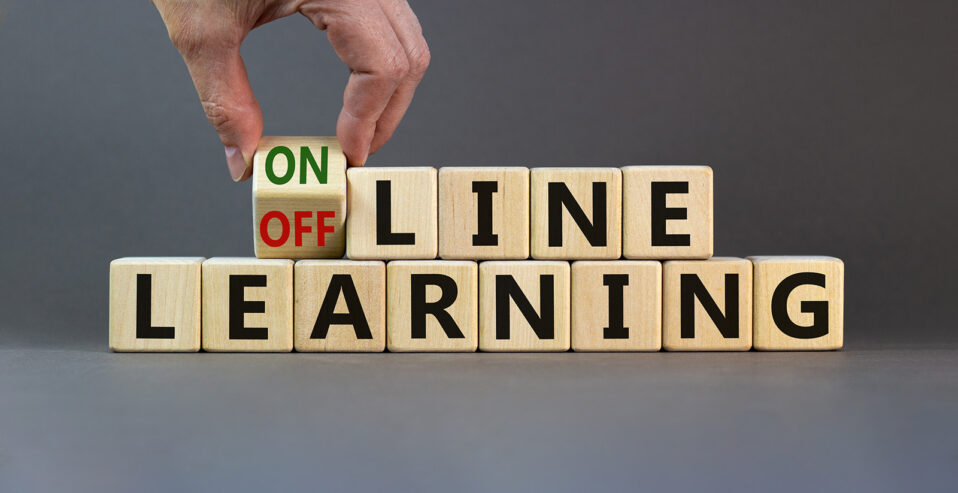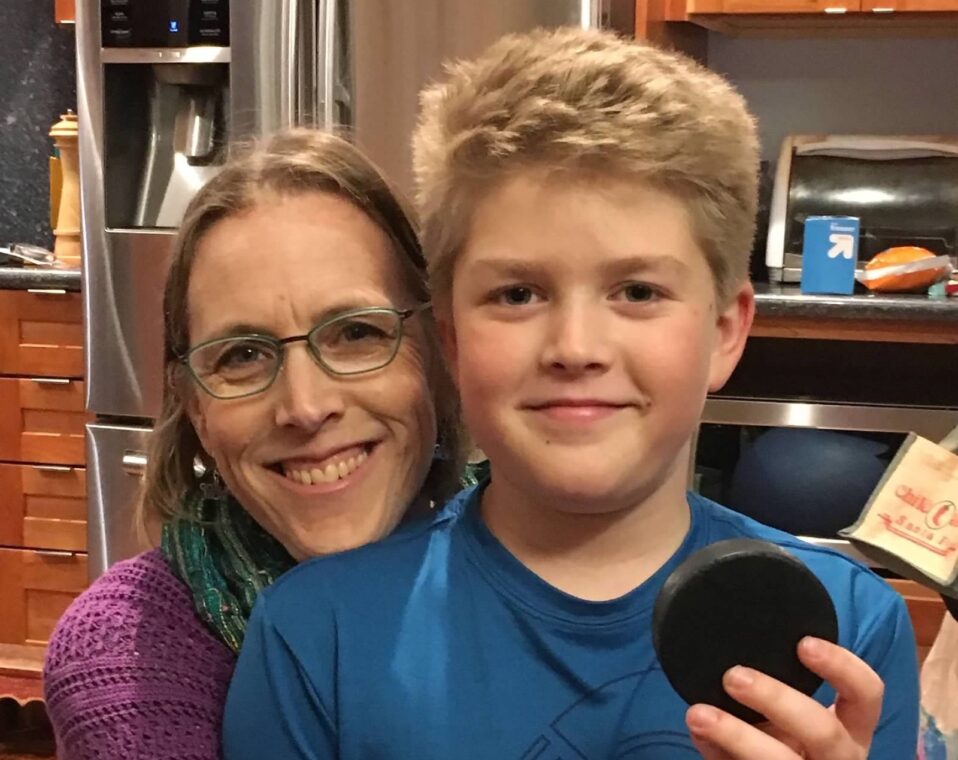By Dana Sheanin, Jewish Learning Works’ CEO and Mindy Gold, Scholar-in-Residence, Bonnie Tenenbaum Digital Learning Initiative.
- Read time: 6 min
- Summary: As we described in Part 1, providing professional learning to educators who are feeling emotionally, intellectually, and physically stretched has proved to be an adaptive leadership challenge framed by two approaches competing for resources and that beg to be connected.
As Jewish LearningWorks reflects on the ongoing goals of Jewish teaching and learning (the balcony view) and the connections to educators’ current lived experiences (the dance-floor view), we know that we need a clearer picture of how to connect these two approaches.
We are intentionally using the metaphor of a “bidirectional staircase” to connect the balcony and dance floor to frame our work. Brene Brown’s 5 C’s for exploring an adaptive leadership challenge are helping to focus our thinking.
Color: What do we observe about blended learning in Jewish education right now?
- Teachers and learners of all ages have significantly increased their digital skills
- Digital tools offer rich opportunities and essential supports that amplify Jewish values and mindsets
- The convenience of synchronous and asynchronous learning increases accessibility to Jewish learning for some, particularly in the area of Hebrew instruction
- There is an ongoing need to find a balance between non-digital and digital tools, which can both play important roles in sustaining our relationships
The BiDirectional Staircase:
The invitation to participate in professional development is best framed by focusing on teaching in general, not just digital skill building. This mirrors best practice for integrating digital technologies in that they are not separate, but can be infused into our teaching if and when they serve a clear purpose and support learning.
An example is Jewish LearningWorks’ new video series which identifies practice-oriented goals first and then why an educator might use digital tools to support that specific teaching strategy. The videos provide asynchronous access and leave space for further exploration personalized to any given educator-viewer’s comfort level. Video topics are chosen specifically to address a “right now” need (i.e., dance floor) while simultaneously addressing larger goals for Jewish education (i.e., balcony). For example, we connect the goal of meeting students where they are socially and emotionally with strategies and tools for using online polling and graphic design software that invite anonymous participation and visual expression. The videos respond to the need to build educators’ skills and understanding of educational technology pedagogy…
Context: What is teaching in Jewish education like today?
- Our teachers and learners are part of many communities, all competing for their time, space, and attention
- While some learners find solace and safety in Jewish learning spaces, digital spaces still evoke fear, resentment, and disequilibrium for some educators and students
- It is an ongoing struggle to balance the potential of blended learning with teachers’ time, energy, and capacity to pursue professional learning
- As a recent CASJE study found, Jewish education is no longer a single field and professional development needs to be tailored to a variety of “practices and purposes”
The BiDirectional Staircase:
In the arena of digital learning, we have shifted away from group sessions at a scheduled day and time, instead opting for 1:1 coaching sessions that are entirely personalized to an educator’s in-the-moment challenges. These individual sessions are scheduled at the convenience of participants, providing a safe space for articulating challenges, setting goals, and identifying resources that target learning and allow for focused use of time and energy. The benefits of instructional coaching are well-documented. Increasing Jewish educators’ access to coaching provides a ground (or dance-floor) up process for building teacher capacity and efficacy embedded in their work, while still addressing field-wide gaps in technological and pedagogical knowledge.
Connective Tissue: What other factors impact this challenge?
- The field of Jewish education has witnessed increased demand for new school models and accessibility as well as a greater focus on early childhood and teens. It’s unclear, however, how often new methodologies are based on the needs of the learners themselves, rather than educators’ ideas about what learners want
- When we emerge from the pandemic, the plethora of possibilities and formats may be overwhelming.
The BiDirectional Staircase:
Conversations can now take place across time zones about the weekly parsha in Snapchat. We can take a Gallery Walk through student illuminations of text without geographical borders in Padlet. We can stroll with a tour guide through the streets of the Old City in Jerusalem without going to the airport. As new models of Jewish learning come to the forefront, we have the responsibility to engage our learners at every level in making active choices about their learning. To support educators in providing these choices, and given the context described above, we must continue to rethink how professional development can help us navigate the staircase. As Jewish LearningWorks learns from our community, we are considering a variety of new interventions that will give educators their own set of choices to identify the skills and growth areas they most need or that are most relevant to their specific educational role. One, micro-credentialing, is a form of professional development where educators learn about and demonstrate proficiency in targeted skills, creating their own personalized progression of learning and mastery of student choice and voice. We are also piloting expansion of 1:1 coaching. We have seen again and again that offering teachers such tools helps increase their capacity to bring student-centered Jewish learning to the forefront.
Cost: What will we give up by dedicating time and space to blended learning professional development?
- In rethinking our use of time, we potentially sacrifice contact time with students in the short term to ensure that teachers have time to plan together for learning and to share what they observe about students thinking and doing
- We may not cover as much content learning for educators
The BiDirectional Staircase:
The professional development shifts we describe thus far do not take place in a vacuum. Rather, we aim for embedded professional learning that invites educators and educational leaders to explore and practice blended learning skills and pedagogies with Jewish content. As we increase teachers’ own knowledge and understanding of Jewish ideas, values, and texts, we enable them to plan for students’ similar engagement. Through professional development practices like peer coaching, observations, and lesson study cycles, we can “borrow” from instructional time to create space for teacher learning that will make our time with students more effective, efficient, and purposeful.
Consequence: What might happen if we don’t incentivize ongoing professional development?
- We run the risk of discounting prior research that demonstrates the need for ongoing, embedded professional development as necessary to bring blended learning into our schools and to ensure it supports curricular and social/emotional goals
- If we silence our curiosity and fail to ask questions about teaching practice and learner goals in the context of a digital world, Jewish education may fall further behind public and private education
The BiDirectional Staircase:
While our efforts this year have sometimes felt like one step forward and two steps back, we have continued taking small steps on that staircase, knowing that while the circumstances for educators are far from optimal, we must continue to advance our learning. Our efforts seek to support teachers in thinking beyond content and focus on pedagogy that is widely applicable and part of ongoing learning about teaching practice. To show our students how important they and their learning are, we invest in those that are often closest to them — their teachers!
Jewish LearningWorks values our students by valuing our teachers. As 2022 begins, we are turning our attention to inviting educational leaders to embrace the view from the balcony in their own settings. While it might be more comfortable to return to what we knew before March 2020, we firmly believe that education must change with the times to be effective. We are committed to harnessing our prior learning, and to identifying ways that Jewish LearningWorks’ staff can model how digital technologies make our work easier and more effective.
As we look around, we see that educators are on the precipice of a shift in perspective toward viewing digital tools not as what forces us to give up or invalidate our values, but rather as modes for enacting our values and practices in new contexts. We will continue to provide tools, skills, mindsets, and support for teachers to help them find the balance between connecting online and in person. As the Jewish LearningWorks team builds on small successes, and resists the temptation to return to what was, we will increase our collective ability to put the needs of learners at the center, and to support them in making Jewish life part of their daily experience.
Free Coaching to Set Up and Maintain Successful Blended Environments
Spend an hour with Mindy Gold, Scholar in Residence at Jewish Learning Works’ Bonnie Tenenbaum Digital Learning Initiative to learn how to combine in-person and digital learning as force multipliers of your teaching and your students’ learning. Ideal for congregational and day school teachers and education directors looking for the right balance for their digital and non-digital classrooms.
About the Authors
Dana Sheanin, CEO, Jewish LearningWorks
Dana Sheanin is Jewish LearningWorks’ first female Chief Executive Officer. She is the founder of Voices for Good, a Jewish LearningWorks initiative focused on amplifying the voices of women professional leaders. Her career has afforded her the opportunity to support a variety of Jewish organizations in the areas of strategic initiative design, organizational capacity building and professional development. Dana believes in the sustaining power of our community’s legacy organizations, and is fortunate to have served two Federations — UJA Federation of New York and the Jewish Federation of the East Bay — as well as the Union for Reform Judaism.
Dana’s professional writing regularly focuses on the need to recruit and invest in the community’s talent pipeline and on the importance of advancing women in Jewish life. She is also the co-author of a chapter on social emotional learning in Reform Jewish education included in Growing Jewish Minds, Growing Jewish Souls. Dana is a proud graduate of the Hebrew Union College School of Nonprofit Management and the University of Southern California School of Social Work. She also trained as a coach at the CoActive Training Institute. She lives with her partner, Sue Bojdak, and four children in Berkeley.
Mindy Gold, Scholar-in-Residence, Jewish LearningWorks’ Bonnie Tenenbaum Digital Learning Initiative
Founder and Lead Consultant of EdtechMMG, an education consulting firm. Her work and research focus on relationship-centered professional learning and educational technology. She is the Graduate Program Leader of the Mandel Teacher Educator Institute (MTEI) and a Coach for the Spertus Institute for Jewish Learning and Leadership. She previously taught as an Instructor for Gratz College’s NEXT program. Mindy holds a Master’s in Teaching from National Louis University (Chicago, IL) and a Certificate in Jewish Education from The University of Cincinnati. She lives in Nashville, TN with her husband and two sons.






